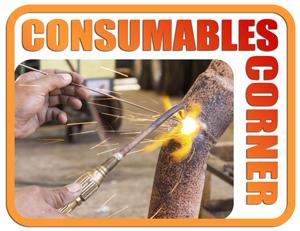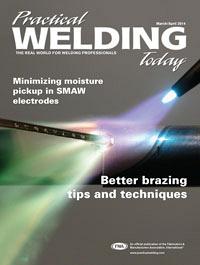Independent welding consumables professional
- FMA
- The Fabricator
- FABTECH
- Canadian Metalworking
Categories
- Additive Manufacturing
- Aluminum Welding
- Arc Welding
- Assembly and Joining
- Automation and Robotics
- Bending and Forming
- Consumables
- Cutting and Weld Prep
- Electric Vehicles
- En Español
- Finishing
- Hydroforming
- Laser Cutting
- Laser Welding
- Machining
- Manufacturing Software
- Materials Handling
- Metals/Materials
- Oxyfuel Cutting
- Plasma Cutting
- Power Tools
- Punching and Other Holemaking
- Roll Forming
- Safety
- Sawing
- Shearing
- Shop Management
- Testing and Measuring
- Tube and Pipe Fabrication
- Tube and Pipe Production
- Waterjet Cutting
Industry Directory
Webcasts
Podcasts
FAB 40
Advertise
Subscribe
Account Login
Search
Consumables Corner: Eliminating porosity in submerged-arc welding
- By Nino Mascalco, Rob Koltz, and Steve Sigler
- June 19, 2014
- Article
- Consumables
Q: Our shop manufactures bridge and structural steel components. Most of the material is A36 or A572 and welded with E70X-X class electrodes using FCAW with 75 percent Ar/25 percent CO2 shielding gas (bottle-supplied) and SAW. We're having issues with porosity in our SAW process. We find that once we weld a SAW root pass, flip the part to the other side, and remove the FCAW tack weld before full welding with SAW, there is porosity trapped at the root of SAW from the other side. However, if we grind from the opposite side of the first SAW pass where there was no tack weld, we do not find any porosity. Any thoughts on where the porosity is originating?
A:There could be one or multiple causes of this porosity. The first thing you should do is grind out a few randomly selected tack welds after you’ve fitted up and tack welded the part and before you begin SAW. Pay close attention when removing the tack welds to see if there is porosity in the weld or near the root of the tack weld.
If porosity is present in the tack weld, it is more than likely being caused by too little or too much shielding gas, contaminants in the joint, or moisture present during FCAW tacking or SAW. Shielding gas levels should fall between 35 and 50 cubic feet per hour (CFH) when measured at the nozzle of the welding gun. Make sure the shielding gas is not being blown away by excessive drafts or fans nearby. Also, check the entire shielding gas supply line and regulator for leaks, which can allow for atmospheric contamination. Also, make sure the weld joint is free of contaminants such as cutting oils.
If the tack welds appear porosity-free, try varying the preheat temperatures before the SAW process. If the WPS doesn't require additional preheat, try adding a preheat and check to see if that makes a difference. If preheat is required, try increasing the temperature and look for any change in the amount of porosity.
Another potential reason for the porosity could be the joint type and penetration ability of the welding consumable and weld parameters. For example, if the bevel is less than 40 degrees on a single-bevel groove weld, the arc of the weld may not be able to penetrate down to the root of the joint. This can sometimes create a pocket at the root and trap slag or, in some cases, cause porosity to form.
If the root of the joint has a tight fit-up and there are tack welds on the opposite side, this can make it difficult for all of the gases to escape. You can address this by increasing the bevel angle to greater than 40 degrees, which will give the weld arc better access to the root of the weld, or by increasing the amperage to gain a deeper-penetrating arc. Also, reducing the root-face dimension will allow the arc to penetrate deeper.
Any single item or a combination of them may help eliminate the porosity issues. Although the process of elimination might be slow, it is important to be methodical and make note of everything attempted. The goal is to correct the problem, but understanding what caused it and how to prevent it is even more valuable.
About the Authors


Rob Koltz
Application Engineer
411 S. Ebenezer Rd.
Florence, 29501
636-485-2253
Steve Sigler
Application Engineer
411 S. Ebenezer Rd.
Florence, South Carolina 29501
636-485-2253
About the Publication
Related Companies
subscribe now

The Welder, formerly known as Practical Welding Today, is a showcase of the real people who make the products we use and work with every day. This magazine has served the welding community in North America well for more than 20 years.
start your free subscription- Stay connected from anywhere

Easily access valuable industry resources now with full access to the digital edition of The Fabricator.

Easily access valuable industry resources now with full access to the digital edition of The Welder.

Easily access valuable industry resources now with full access to the digital edition of The Tube and Pipe Journal.
- Podcasting
- Podcast:
- The Fabricator Podcast
- Published:
- 04/16/2024
- Running Time:
- 63:29
In this episode of The Fabricator Podcast, Caleb Chamberlain, co-founder and CEO of OSH Cut, discusses his company’s...
- Trending Articles
Sheffield Forgemasters makes global leap in welding technology

ESAB unveils Texas facility renovation

Engine-driven welding machines include integrated air compressors

The impact of sine and square waves in aluminum AC welding, Part I

Compact weld camera monitors TIG, plasma processes

- Industry Events
16th Annual Safety Conference
- April 30 - May 1, 2024
- Elgin,
Pipe and Tube Conference
- May 21 - 22, 2024
- Omaha, NE
World-Class Roll Forming Workshop
- June 5 - 6, 2024
- Louisville, KY
Advanced Laser Application Workshop
- June 25 - 27, 2024
- Novi, MI



























